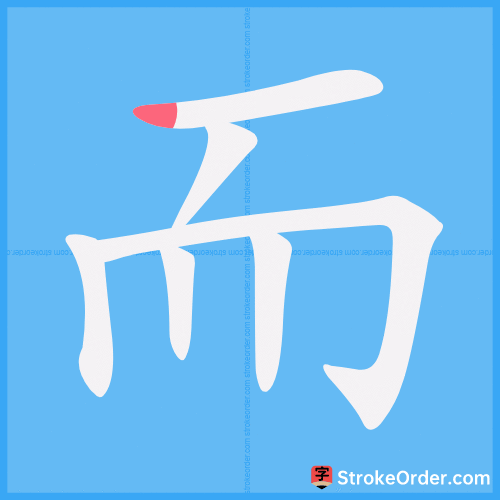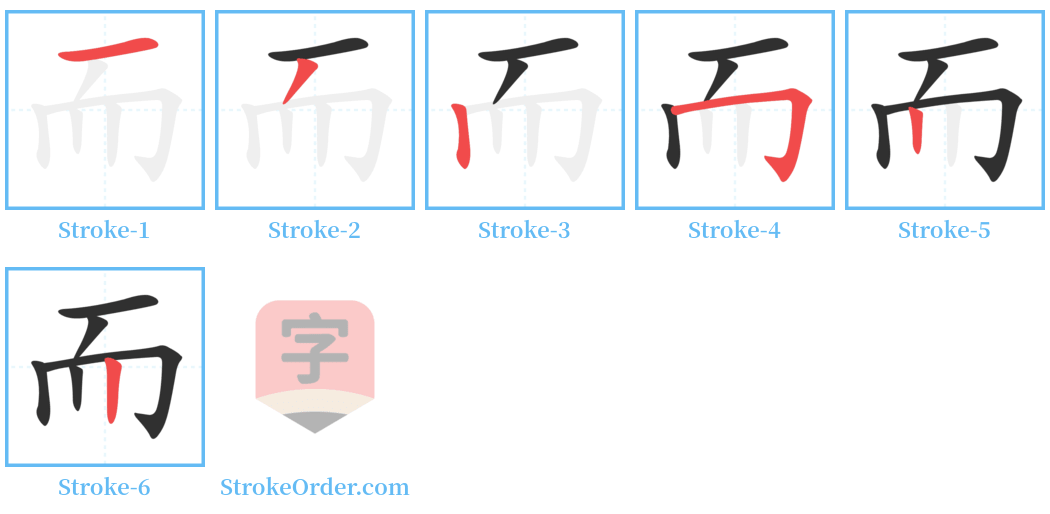而 Stroke Order
Animated Stroke Order of 而

Stroke Order Diagrams for 而

Step-by-Step Handwriting Guide for 而

Learn to Write Chinese Characters with Video Tutorials
Watch the video of writing the Chinese character "而", learn the correct stroke order (笔顺) of the character "而", and master the standard way of writing the character "而".
Free Printable Handwriting Practice with Stroke Order: 而
Printable Writing Practice Worksheet of "而" in Portrait Orientation (Tian Zi Ge)

Printable Writing Practice Worksheet of "而" in Landscape Orientation (Tian Zi Ge)

Information of 而
Pinyin
ér
Radical
而
Strokes
6 strokes
Usage
★★★★★
Definition
and / as well as / but (not) / yet (not) / (shows causal relation) / (shows change of state) / (shows contrast)
而 ér
(1) *Pronoun*
- Anciently same as "尔", meaning you or your.
- Examples: “而翁归,自与汝复算耳” (When the old man returns, I will recount it with you).
(2) *Conjunction*
- Functions as a connector for words, phrases, and clauses, indicating various relationships.
a. Indicates a parallel relationship, e.g., “多而杂” (many and mixed).
b. Indicates a continuative relationship, e.g., “取而代之” (to take over).
c. Indicates a progressive relationship, e.g., “而且” (furthermore).
d. Indicates a transitional relationship, e.g., “似是而非” (seemingly right but in fact wrong).
e. Connects affirmation and negation, indicating mutual supplementation, e.g., “浓而不烈” (strong but not overwhelming).
f. Connects adverbial modifiers and main words, e.g., “侃侃而谈” (speak eloquently).
g. Inserts in between a subject and predicate to express hypotheticals, e.g., “人而无信,不知其可” (If a person is untrustworthy, it’s hard to say what is possible).
(3) *Expresses range* (from... to...)
- From top to bottom, e.g., “从上而下”.
(4) *Noun*
- The character is pictographic. It resembles the shape of a beard. The upper part means the tip of the nose, while the lower part represents jaw hair. The original meaning is bristles on the jaws.
- “而,颊毛也。” (Er, refers to bristles on the jaws.) — from "说文".
(5) *Illustrative examples of the conjunction*
- "永州之野产异蛇,黑质而白章。" (In the fields of Yongzhou, there are strange snakes, black-bodied and white-marked.) — Liu Zongyuan, "捕蛇者说".
- "君子博学而日参省乎己。" (A gentleman is well-read and constantly reflects on himself.) — from Xunzi, "劝学".
- "青,取之于蓝,而青于蓝。" (The color blue comes from indigo, but it is bluer than indigo.) — from Xunzi, "劝学".
- "吾恂恂而起。" (I rose with a careful manner.) — Liu Zongyuan, "捕蛇者说".
(6) *As an auxiliary verb*
- Indicates a relationship akin to “of” or “that”.
- "虞之与虢,相恃而势。" (The states of Yu and Guo support each other in strength.) — from "淮南子·人间".
(7) *As a rhetorical question*
- Used in questions, equivalent to “how could” or “how is it possible”.
- “为仁由己,而由人乎哉?” (Is it the kindness from oneself, or from others?) — from "论语·颜渊".
(8) *As a verb*
- To seem or appear.
- “溺死者千有余人,军惊而坏都舍。” (Over a thousand people drowned in the Army's panic.) — from "吕氏春秋".
通“能”.
而 ér
(1) *Noun*
- Ability or talent.
- "然计天下之所以治者,何也?唯而以尚同一义为政故也。" (What accounts for governance under heaven? It is precisely by advocating for the same principle in governance.) — from "墨子·尚同下".
(2) *As a verb*
- To be able to, can.
- "不待我而有成事者也。" (There are those who achieve without needing me.) — from "商君书".
lit. the cycle comes back to the start (idiom); to move in circles / the wheel comes full circle
lit. sth hits one in the face / directly in one's face / sth assaults the senses / blatant (advertising) / eye-catching / (a smell) assaults the nostrils
lit. to slap the table and stand up (idiom); fig. at the end of one's tether / unable to take it any more
Input Method for 而
Pinyin
er2
Wubi
dmjj
Cangjie
mbll
Zhengma
gl
Four Corner
10227
Unicode
U+800c
Same Pronunciation Characters